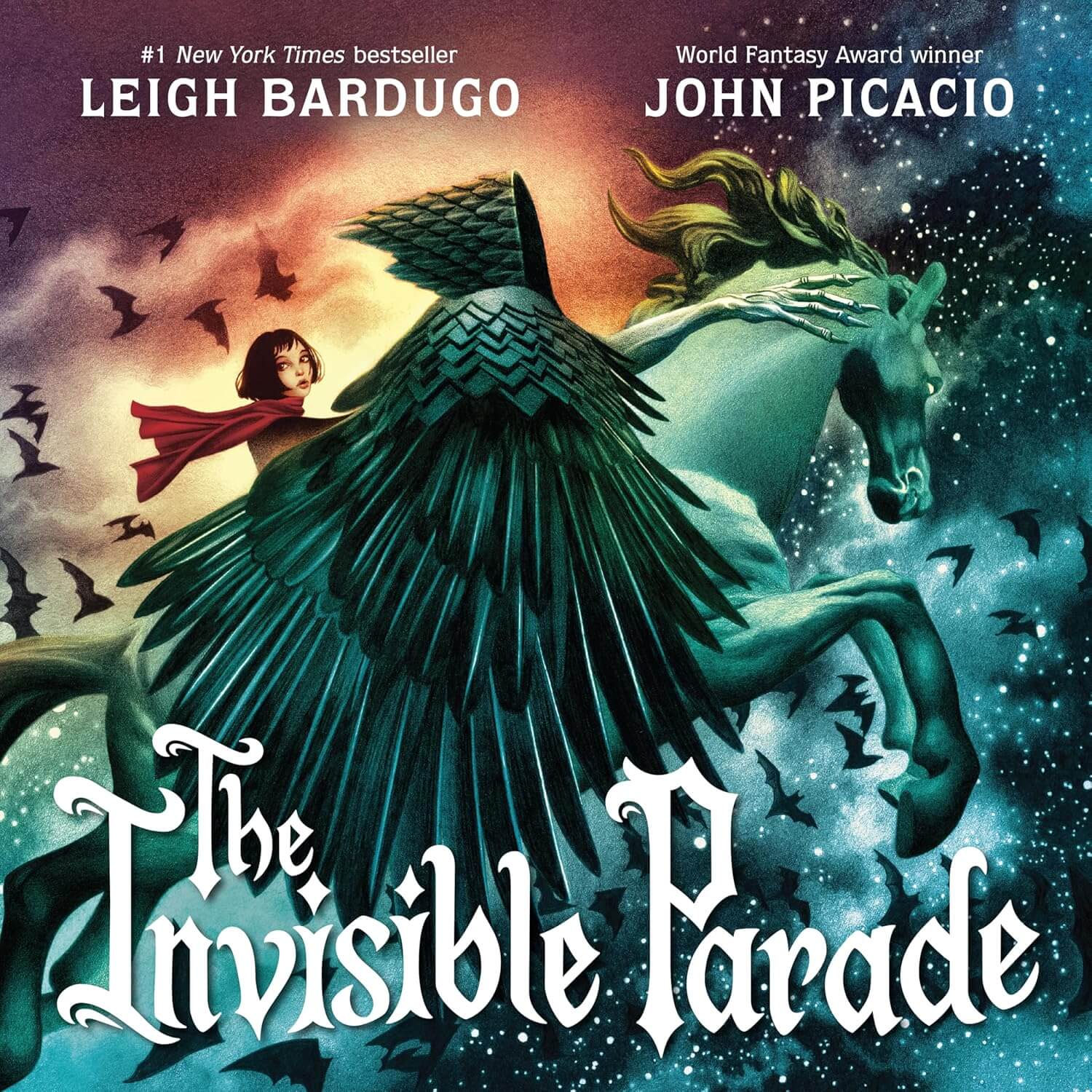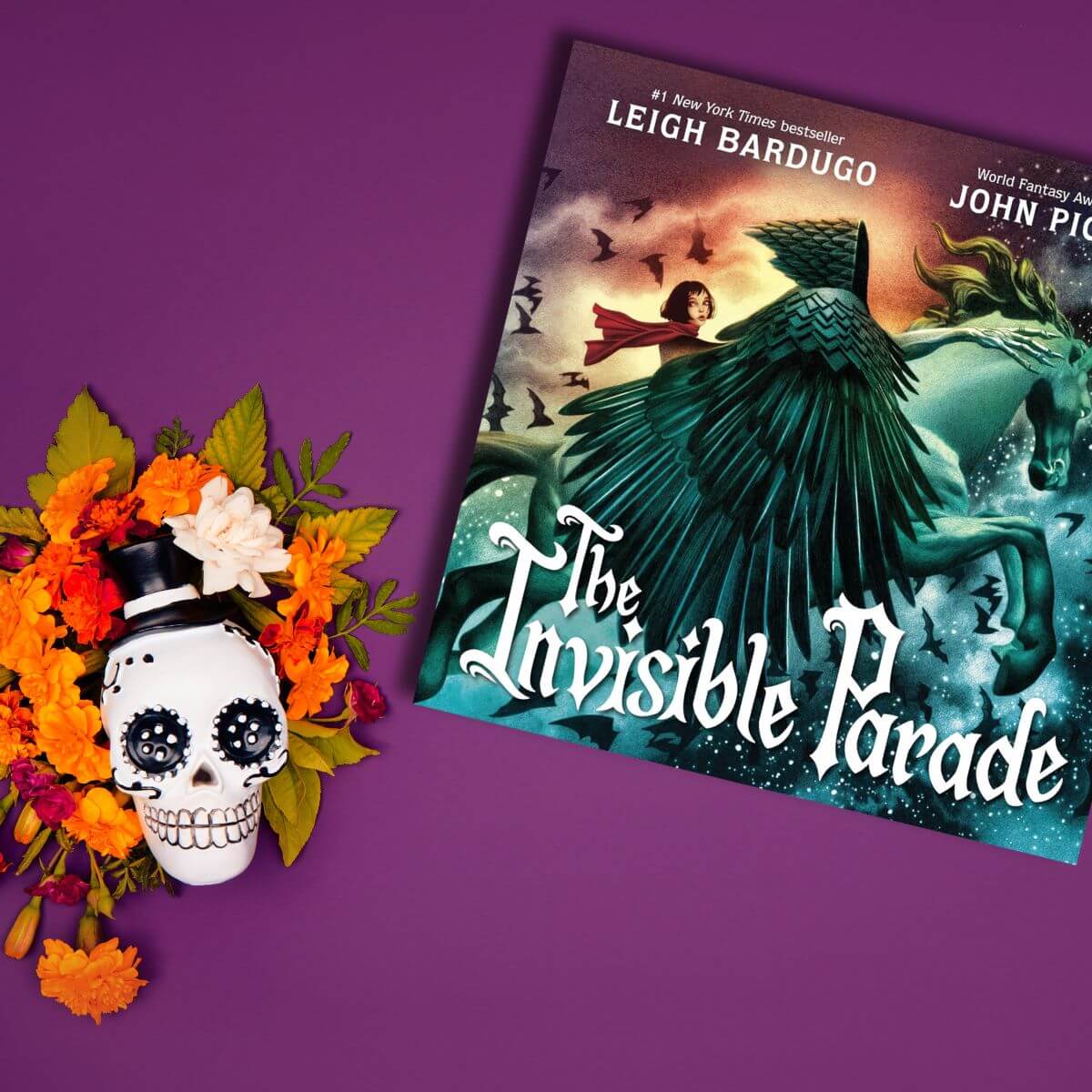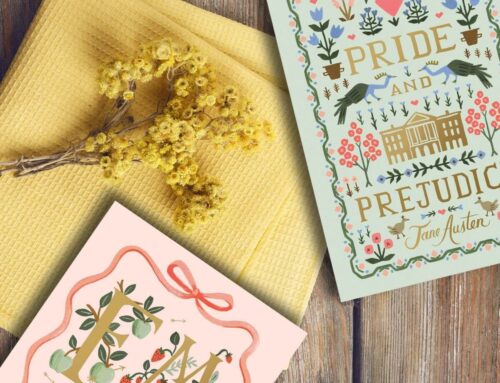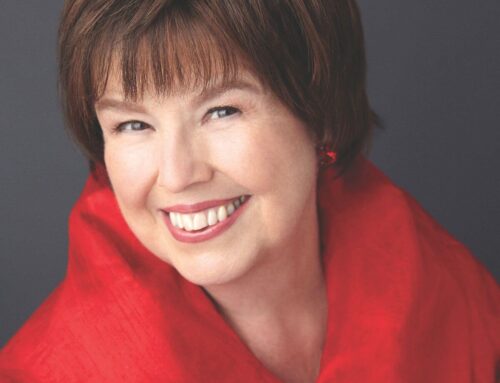Leigh Bardugo gained acclaim and a fandom through her Young Adult fantasy creation The Grishaverse, an expansive world with magic, heists, and characters that seem to leap off the page and straight into her readers’ hearts. John Picacio is a World Fantasy and Hugo Award-winning illustrator who also spearheads a creative publishing imprint. Together, Leigh’s fantasy worlds and John’s gorgeous illustrations came together to bring us The Invisible Parade, the duo’s debut picture book, released Sept. 2, 2025.
The Invisible Parade is, from the smallest brushstroke to the longest sentence, a work of incredible art. The story follows a young girl named Cala and explores grief through four horse riders on the night of Día de Muertos.
Leigh and John corresponded with She Reads contributor Karis Rogerson to answer a Q&A about their collaborative process, the heart behind the story, and hopes for the future.
Both Authors:
This book is such a work of art – from the story in words to the story in art to the construction of the book itself. I’d love to know how your collaborative effort to create this piece of magic came together, logistically speaking; what was the creation process like, and what was the journey to publication?
John: I had an idea for a story about a grieving girl visiting a graveyard who meets four riders on the night of Día de Muertos. I knew the basic beats of the story, and I knew I wanted to co-create it with Leigh because she’s not only one of the great American storytellers, but we laugh a lot, and I trust her. Our friendship predates The Invisible Parade by several years, and I thought we could create an amazing story together.
Leigh: John pitched me this book over ten years ago, and as soon as he said “It’s The Wizard of Oz set in a graveyard,” I locked in. We started by just sharing ideas and influences, everything from Octavio Paz to Alexander McQueen. We visited cemeteries together and art exhibits. We talked about our own connection to grief and what we wanted to offer people with this book. We worked on that story until it didn’t really belong to either of us, but to Cala, our heroine.
How did you think about achieving the balance in tones in the book? I experienced such a range of emotions reading, from giggling to crying, which I find lovely, and I’d love to know how you achieved that tonal shift.
Leigh: I’m so happy to hear that. Because that’s the experience of grief too, isn’t it? We have joyful memories, painful memories. When I lost my dad I found that line between laughter and tears frayed pretty easily. We wanted this story to be an adventure, a modern kind of fairytale. That meant it needed suspense and some scares. We knew we wanted to offer families and friends a new way to talk about grief and that meant not shying away from the heavy stuff. But humor is my coping mechanism. It makes the path a little less scary and loss a little more manageable.
John: We orchestrated the story with every single spread, even down to our very clear choices for the tempo of our color shifts and how we wanted color to present Cala’s emotional journey. We worked hard to create a counterpoint between image and text and it makes me happy that our work resonates.
What was the most challenging aspect of creating this story?
Leigh: For me it was the early drafts of the text and finding the lessons that each horseman offers Cala, making those feel authentic and not like some kind of lecture.
John: Designing the horsemen was one of the most challenging, but also one of the things I most looked forward to, and most enjoyed. They were designed in sketches and maquettes, and we wanted our horsemen to be unlike any seen before in all the centuries of depictions of these icons. We gave them our best, and they were a joy to discover.
What was the most fun or rewarding aspect of creating this story?
Leigh: I think it’s happening now that the book is in the world. Sharing stories with readers, seeing their response to John’s art and the narrative we created together.
John: For me, I think it’s the moments when Leigh and I would bump up against each other, and neither of us was in love with what the other was seeing. And in those moments, we always found a next level that was beyond the place we started from. We elevated each other.
For Leigh:
How did your process change when you sat down to write this book, knowing the intended audience is so much younger than even the YA readers of your Grishaverse books?
I think the story lets you how to tell it. You just have to listen. Cala’s grief was so real to me and a strong echo of my own experiences, so I let her talk and I tried to use the language she used. And I was a kid who absolutely loved spooky stuff so I think John and I felt comfortable navigating that happy space between the laugh and the gasp.
This book feels like it fits in so well with the rest of your bibliography, despite being for a younger core audience. It’s still so very Leigh Bardugo. How do you think about your work in a broad sense, in terms of themes you return to repeatedly?
I’m always focused on the story in front of me, so it’s strange to suddenly look back on a decade and realize I have a body of work. My stories are often dark. They’re often about characters who don’t take the moral path. But I think every story is really about trying to connect—to the people around you, to tradition, to the magic waiting in the world if we can only open ourselves to it.
Do you have any advice you’d offer to young and/or aspiring authors, either about honing their craft or finding joy/perseverance in their journeys?
We live in a world that doesn’t honor the work of creating. Everything is reduced to a montage or a before-and-after. So, we have a choice as people who want to make things: We can take the easy path, use AI, flatten our work to fit into whatever new trend hits, or we can turn toward the weird, the difficult, the challenging. That second road is harder, but I think it’s also more gratifying. Learn to accept that discomfort is essential to the process of creating. Read broadly. And most importantly, remember that there is no expiration date on your talent.
From the author’s note at the back of the book + your dedication, I know this book was inspired by your love of and grief for your grandfather. Would you be willing to share a story about your grandfather that has meant a lot to you and that helped you as you formed the story for this book?
Every day when I came home from school, I’d sit down next to my grandfather in our little back yard and he’d say, “Tell me some lies.” He didn’t just want the news of my day. He wanted a story. He never got to see me publish, but my first book is dedicated to him, and I used those same words in his memory: Tell me some lies.
For John:
I’d love to know what inspired you to reach out to Leigh specifically to co-create this story with you.
I love her storytelling sense, and I trust her. Yes, we were friends before her first book was published, but I also had been keeping up with her published work, and I thought her sensibilities would mesh well with mine on this story. We’re both goths at heart.
The art in this book is so utterly stunning. I love seeing Cala’s journey throughout its pages, specifically as reflected in the light/look in her eyes. But I also noticed the coloring as it changed throughout the book. Did you always know how you wanted the book’s art to look, or was that a process of exploration and discovery that came over time?
From the beginning, I knew the story would start in sepia and gradually open up to technicolor. That was part of the melody that I already knew before I asked Leigh to co-create this book with me. But she and I thought of that color arrangement like we were conducting an orchestra, and so the timing of that build was very much a team effort. The notion of using color to describe Cala’s emotional journey is essential to our story.
Do you have any advice that you’d offer to young and/or aspiring artists, especially ones who might find themselves feeling lost on the path to achieving their dreams?
There’s what you like, and there’s what you love. Pay close attention to the things you love, and why you love them. That’s where the real joy is. When you can channel that love into the work you share with the world, it can’t help but make it better, and hopefully make it more personal. The weirder, the better. We need more weird in this world.
What other of your own stories do you see yourself working on/hope to create and tell next?
When we co-created The Invisible Parade, I didn’t do so with the notion of continuing on as a picture book creator. I was just trying to survive the process and make the best book I could. But now that it’s over, I’m in love with the process. And yeah, I’ve got another picture book in my head. I can see the beats. I can feel the story’s melody. And I can feel the heart of this kid and she haunts me every day right now. So that’s where I’m headed next, as well as back to my world of Lotería.

The Invisible Parade by Leigh Bardugo and John Picacio
Everyone is excited for the Día de Muertos party, except Cala, who is still grieving her grandfather and afraid to attend the celebrations. But when she’s separated from her family at the cemetery, Cala meets four elusive riders who help her realize that true bravery was inside her all along. Readers of all ages will relish this humorous, heartfelt exploration of grief and inner courage.
Buy the book now: Bookshop.org | Amazon | Barnes & Noble







Leave A Comment